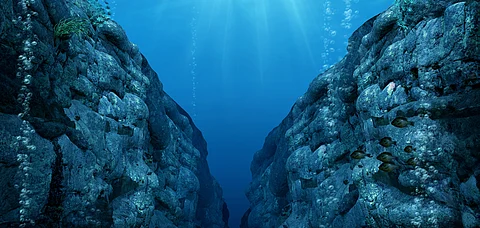
- Destinations
- Experiences
- Stay
- What's new
- Editor’s Picks
- Responsible Tourism
- CampaignsCampaigns
- Subscribe

As vast as the planet and undiscovered like space are the depths of the ocean. While we continue to make progress in biological discoveries, there are some parts of the ocean that are so inaccessible, that despite perpetual attempts, we have only discovered a sliver of the truth. The Mariana Trench is not a part of this sliver. The lowest part of the ocean, this area surrounds the Mariana islands near Japan. So, what lies in these treacherously deep, dark waters. Find out if you can afford a scare.
Dumbo Octopus
Flappy ears, deep-set eyes and eight tiny tentacles named after the Disney favourite, the Dumbo Octopus is arguably the most eye-soothing sight, found at least 9,800 metres under the sea in the Mariana trench. Hardly spooky, these adorable 8-12 inch creatures stream through the ocean by flapping their ears. Charming as they may be, the dumbo octopus is a predator that can swallow its prey in one gulp.
Scientific name Grimpoteuthis
Comb Jellies
Visually captivating, Comb Jellies are gelatinous creatures with luminous body structures as they diffract any light that falls upon them. They use their comblike plates to move around in the water. While they please the eyesight, these underwater marvels are voracious predators, even attacking their own kind sometimes. Some may be as tiny as a few millimetres, ranging up to nearly 5 feet long.
Scientific name Ctenophora
Benthocodon
While we know most jellyfish to be transparent, the Benthocodon is in fact an opaque creature. A red-coloured cover called the bell veils the lumination of the creatures eaten by the Benthocodon, keeping it out of a predator&rsquos sight. With approximately 1,500 tentacles, it cruises through the ocean.
Scientific name Benthocodon hyalinus
Deep Sea HatchetFish
A rather sour-looking creature, the deep sea Hatchetfish is a fairly small creature, generally ranging from 2.8 cm to 12 cm. While the tiny size makes it an easy prey, the Hatchetfish has evolved to form an ingenious camouflaging technique. As most other deep sea animals, these fish are also bioluminescent with their ability to produce light from their stomach. Revealing your silhouette in the ocean can be dangerous and thus the Hatchetfish can control the light to match exactly with the light in the water, making it essentially invisible to the predators.
Scientific name Argyropelecus Gigas
Barreleye Fish
Like a clear plastic bag failing at hiding any of its contents, the Barreleye Fish&rsquos transparent head reveals all of its contents filled with fluid. This membrane also protects the fish from stings when it preys on the jellyfish. Its flat fins help it stay completely still and move with absolute precision in the dark seas. Despite lurking in astonishing depths of the ocean, the fascinating creature has been picked up in fishing nets.
Scientific name Opisthoproctidae
Black Seadevil/ Seadevil Angler Fish
Any fan of Finding Nemo might quickly recognise this fish. Featured as a scary creature in the film, the Black seadevil is just as terrifying in real life. Sharp teeth, gaping mouth and eyes exploding out of their sockets this angler fish is known for its luminous antenna-like muscle protruding from its head. This light attracts its prey into close vicinity for an easy catch. An interesting and potentially scarring fact, the black seadevil reproduces when the male fuses into the female and living off her resources until it can produce sperm.
Scientific name Melanocetus
Ping Pong Tree Sponge
Do not judge a book by its cover. While the name may be a laugh, the Ping Pong Tree Sponge sure isn&rsquot. The thin, stalk-like creature is named such because of its appearance it literally looks like a tree producing ping pongs. These &ldquoping pongs&rdquo are dotted with tiny hook-like extensions. Any prey that comes in contact with it is trapped and then the sponge slowly devours the prey live. The ridiculous name didn&rsquot suggest these results, now did it
Scientific name Chondrocladia
Frilled Shark
As if other sharks were not scary enough, in comes the Frilled Shark, a truly chilling phenomenon. Its name can be attributed to its frilled gills, of which it has 6 or 7, as compared to the usual 5. With a slender snake-like body, the shark looks more like an eel. Apart from its entire physique, the most eerie feature of this shark is its set of 300 teeth Despite the fact that this shark lives at least 5000 metres below the surface, it was one of the first deep-sea animals to be discovered, in the 19th century.
Scientific name Chlamydoselachus Anguineus
